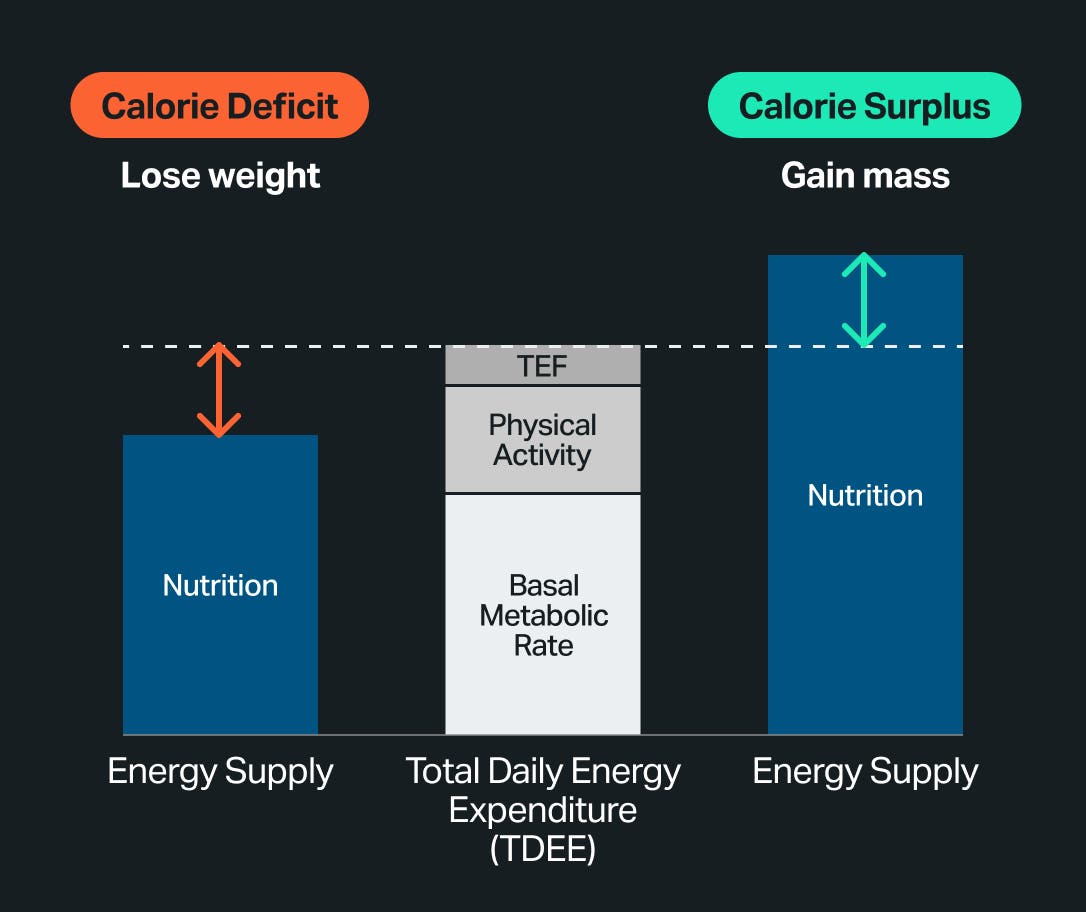We’re surrounded by talk of calories – endless fad low-calorie diets and misinformation about how much we should or shouldn’t eat to see results. But what exactly is a calorie? Let’s dive in.
In simple terms, a calorie is a “measure of energy”.1 One calorie is the amount of energy it takes to increase the temperature of 1 gram of water by 1 degree Celsius.
However, when we’re talking about calories and health, calories are the amount of energy the body can use from the foods and drinks you consume. Calories are used for just about everything you do, from unconscious activities like growing and breathing to conscious things like moving and thinking.
Different macronutrients provide different amounts of energy. For example, carbohydrates and proteins contain 4 calories per gram while fat gives your body 9 calories per gram.
Overall, calories are a unit of energy that measures how much energy food and drinks can provide. Contrary to popular belief, calories are not bad for you.
Calories in vs calories out
The term “calories in vs calories out” is the concept of creating a calorie deficit by eating fewer calories than your body uses in a day to promote weight loss. If you do the opposite and eat more calories than you burn, also known as a calorie surplus, you’ll gain body mass.
However, there are other factors (such as your activities) that determine what kind of mass (i.e., fat or muscle).
Although creating a calorie deficit will contribute to weight loss, the idea of “calories in vs calories out” is simplistic and doesn’t take into account other factors like the macronutrient content and quality of your diet.
Outside of a laboratory, it’s incredibly difficult to accurately track the exact amount of calories you are getting from food and the amount of energy you are burning. Plus, how your body processes calories is unique to you.
So, you may eat the exact same number of calories as a friend, but your bodies may respond in completely different ways because of factors such as your metabolism and the composition of your gut microbiome.
Expert tip: Prioritizing high-quality, nutrient-dense foods is more important than calorie counting, no matter what your fitness or weight goals are.

Calories in
If you’re proactively scanning food labels, you’ve probably noticed the total number of calories displayed clearly on the packaging for that specific food. However, the total number of calories simply tells you how much energy it will provide, not how nutritious it is for you.
Rather than focusing solely on caloric intake, it’s often a better approach to prioritize nutrient-dense foods. What’s more, the types of foods that have had minimal processing usually contain lots of other important nutrients, like fiber, healthy fats, proteins, and whole carbohydrates. And they tend to naturally have a relatively low-calorie content. These foods include:
- fruits
- vegetables
- nuts
- seeds
- wholegrains
- legumes
- lean meat
- seafood
- dairy
What is meant by the term “empty calories” and why should you avoid these foods?
The term “empty calories” is used to describe a food that has lots of calories but is low in nutrients, more commonly known as “junk food”.
These foods are often packed with fats and added sugars, such as:
- sugary drinks (soft drinks, sodas, energy drinks)
- chips
- cookies, cakes, pastries, doughnuts
- pizza
- ice cream
- processed meats (sausages, bacon, hot dogs, deli meats)
- alcohol
Impact of calories on metabolism
Your metabolism, the chemical reactions that take place in your body to convert food into energy, can be impacted by several things in your diet, including the ratio of carbohydrates, proteins, and fats.
The thermic effect of food (TEF) refers to the energy your body uses to digest, absorb, and metabolize food.2 It accounts for around 10% of our daily energy expenditure.3 However, it can vary between individuals and depend on the macronutrient composition of our meals and even our age.
Protein burns more calories during digestion and processing compared to fats and carbs. That’s because breaking proteins down requires more energy due to their complex structure.
So, protein has the highest TEF of around 20 to 30%, followed by carbohydrates (5 to 10%), and fat (0 to 5%). Whole foods, like brown rice, also have a higher TEF than their processed or white counterparts.
That’s why eating a balanced diet with an adequate protein supply can slightly boost your calorie expenditure. However, balance is key – eating too many calories per day with too little exercise can have a negative effect on metabolism and weight management.

Calories out
Your calorie expenditure or “calories out” is the amount of calories you burn daily or how much energy you have used up. How many calories you burn changes every day and varies from person to person because of factors like age, height, weight, and activity level.
Your body will also use calories for different purposes. The reason we need calories to survive is because they give us the energy that powers all of the functions that keep us alive, like breathing, digestion, blood circulation, and maintaining our hormone levels. All of these functions burn calories.
Although calorie counting isn’t an exact science, as we mentioned above, you can estimate your daily calorie needs by calculating your total daily energy expenditure or TDEE. To do this you’ll first need to calculate your basal metabolic rate (BMR), which you can do using the Mifflin-St. Jeor equation4:
- Men: 10 × weight (in kilograms) + 6.25 × height (in centimeters) – 5 × age (in years) + 5
- Women: 10 × weight (in kilograms) + 6.25 × height (in centimeters) – 5 × age (in years) – 161
For example, if you are a 30-year-old male who weighs 85 kg and is 181 cm tall. You would calculate your BMR in the following way:
10 x 85 + 6.25 x 181 - 5 x 30 +5 = 1836.25
That means your BMR is 1811. This is the number of calories your body needs at rest.
Now you have your BMR, you can calculate your TDEE by multiplying your BMR by one of the following activity factors:
- Sedentary (little to no exercise): 1.2
- Lightly active (light exercise or sports 1-3 days a week): 1.375
- Moderately active (moderate exercise or sports 3-5 days a week): 1.55
- Very active (hard exercise or sports 6-7 days a week): 1.725
- Super active (very hard exercise and a physical job or training twice a day): 1.9
If we use the earlier example, we can calculate the TDEE if the person is moderately active as follows:
- BMR x activity level = TDEE
So, for our example, the calculation would be as follows:
1836.25 x 1.55 = 2846.19
The TDEE value tells you the amount of energy your body needs every day when your activity level is taken into account. This includes non-intentional physical activity and the less rigorous exercise you do during the day, also known as non-exercise activity thermogenesis (NEAT).
So, if you’re looking to lose weight, then you may consider increasing your TDEE to create an energy deficit. You can do this by increasing your daily activity level through intentional exercise, like training, or simple changes like taking the stairs instead of the elevator or walking to work rather than driving.
Equally, if you want to increase your weight or gain muscle, you’ll need to increase your calorie intake to be more than your TDEE. For gaining muscle, you’ll likely focus on increasing your protein intake and completing resistance training sessions.

Calories count vs counting calories
Calories count and counting calories sound the same, but they actually have slightly different meanings.
“Calories count” refers to being conscious of the amount of calories in the food or drink you are consuming. For example, a slice of whole wheat bread contains around 69 calories while a can of popular branded cola may contain 139 calories. Understanding the calorie count of your typical food choices can help you gauge how energy-dense your food is and make informed decisions about whether and how much of it to eat.
“Counting calories,” on the other hand, is when you keep track of the total number of calories you consume in 24 hours. Tracking your calories for a typical week in your life can be a good way to help you understand the calorie content of the food and drink you consume. This can be a useful tool to help you determine which changes to the foods you eat are necessary based on your physical activity levels.
However, we can’t emphasize enough that calorie counting isn’t the only way to achieve your goals. In some cases, it can even lead to an unhealthy relationship with food. Instead, focus on factors like the macronutrient content of your foods, portion control, and the type of exercise you do each day. These are equally important and should not be overlooked.
Let’s recap
The fact is, calories are essential for fueling your body’s everyday functions and activities, but not all calories are created equal. It’s important to prioritize nutrient-dense foods and ensure your energy intake is balanced with your expenditure to support your overall health and help you achieve your fitness or weight goals.
Whether you’re looking to lose, maintain, or gain weight, focusing on diet quality, exercise, and sustainable and healthy habits will have a far greater impact than simply calorie counting.
Sources
[1] Osilla EV, Safadi AO, Sharma S. Calories. [Updated 2022 Sep 12]. In: StatPearls [Internet]. Treasure Island (FL): StatPearls Publishing; 2024 Jan-. Available here
[2] Reed, G. and Hill, J. (1996) ‘Measuring the thermic effect of food’, The American Journal of Clinical Nutrition, 63(2), pp. 164–169. doi:10.1093/ajcn/63.2.164.
[3] Du, S. et al. (2013) ‘The thermic effect of food is reduced in older adults’, Hormone and Metabolic Research, 46(05), pp. 365–369. doi:10.1055/s-0033-1357205.
[4] Mifflin, M. D., St Jeor, S. T., Hill, L. A., Scott, B. J., Daugherty, S. A., & Koh, Y. O. (1990). A new predictive equation for resting energy expenditure in healthy individuals. The American journal of clinical nutrition, 51(2), 241–247. Available here